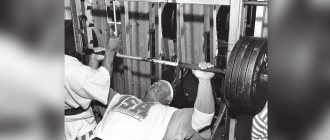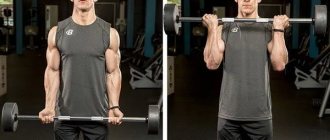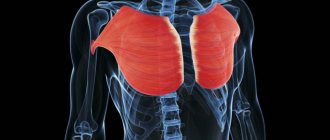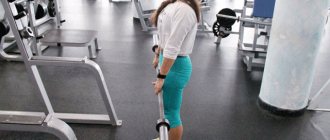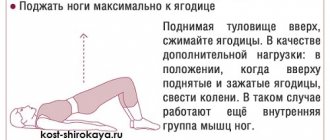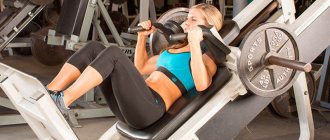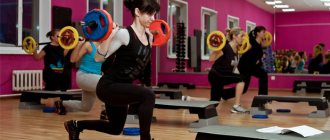The bench press is one of the most popular exercises. To complete it, sometimes you have to wait: a rack with a horizontal bench is almost always occupied. There is no need to waste time waiting: the equipment for the incline version of bench press training is often empty, especially since horizontal bench press alone is not enough to improve physical fitness.
- Incline Barbell Press: Distinctive Features
- What muscles are involved in the work?
- Benefits of Exercise
- How to choose a bench angle
- Technique for performing incline bench press
- Incline Bench Press
- Video: Nuances of the bent-over barbell press
- Bench press on an incline bench upside down
- Video: Technique for working with a barbell in a downward bend
- Smith Machine Angle Bench Press
- Video: Smith machine training
- Narrow or wide: different types of grips when working on an incline bench
- Incline bench press for girls
- Video: Example of a women's training program including the incline bench press
- Practical tips for performing the exercise
Incline Barbell Press: Distinctive Features
The bench press exercise with a barbell, performed at an incline, is basic because it involves several joints and muscle groups at the same time. It is a variation of the classic training using a horizontal bench. Changing the starting position results in a different load distribution, allowing, depending on the selected inclination, to work out the target area in more detail.
Competitive athletes usually perceive this press as an auxiliary element of training, since it involves working with lighter weights compared to the classic version. However, in amateur sports, the main goal of training is not to lift the maximum possible weight, but to perform high-quality muscle development and generally improve physical fitness. The incline press does a great job of achieving these goals.
What muscles are involved in the work?
The main load in this exercise is borne by the pectoralis major muscle, which anatomically has two heads:
- clavicular, located on the front side of the collarbone;
- sternocostal, covering the lateral region of the sternum and the 6 upper ribs.
Conventionally, this muscle mass is divided into three sections - upper, middle and lower. By changing the angle of the bench, you can shift the load, activating a particular area more strongly in accordance with your training goals.
The following muscles are involved in movement as auxiliary muscles:
- triceps;
- anterior deltoid bundle;
- pectoralis minor muscle;
- serratus anterior muscle.
m
Benefits of Exercise
Experienced athletes agree that the overhead incline press puts more strain on the pectoral muscles compared to training on a flat bench. This is due to the fact that in the “classic” a significant part of the load is taken by a stronger area - the lower chest. In addition, the triceps are actively involved in the movement. With an upward angle, these muscle masses are activated less and the movement is performed primarily in the middle and upper chest. This allows you to better work out muscle groups that are, as a rule, lagging behind.
With
The incline press has more variety than the horizontal press. By changing the starting position, the athlete can shift the emphasis of the load to different areas of the chest, triceps or deltoids, depending on the goals of the exercise.
This version of the pressing movement allows you to effectively use a larger number of muscle groups while working with lighter weights.
Features and benefits of the exercise
An incline press is lifting a barbell or dumbbells from a bench at a special amplitude. This allows you to use the small and large sternocostal, clavicular, and abdominal muscles. This position also activates the muscles of the legs and back. The deltoids and triceps help you press the barbell. For those who have poorly developed breasts at the bottom or top, it is advisable to move on to exercises at an angle. The classic press mainly loads the central part.
You can perform a bench press while lying on an incline bench either upside down or down. By changing the technique, the desired breast relief is reproduced.
The advantages of the incline press include the work of different muscle groups and a minimum of contraindications. There are still limitations in performing this type of exercise. These workouts are not advisable for those who have diseases or injuries of the back or shoulder joints. Sometimes a bench press with dumbbells is allowed, provided that the deflection in the lumbar region, the angle of inclination are controlled, and the load on the working muscles is evenly distributed. If you can’t figure it out on your own, it’s advisable to turn to a professional. Before going to the gym, it would be a good idea to consult a doctor.
An incline bench allows you to lift a barbell or dumbbells in a special amplitude
You can perform the bench press on an incline bench either upside down or upside down.
How to choose a bench angle
The degree of development of a particular area of the upper body depends on the angle at which the athlete will position himself.
When adjusting the position of the backrest, you need to take into account that the smaller the angle of inclination, the more the triceps are activated. As the angle increases, the working emphasis gradually shifts to the front deltoids. It is important to set the inclination so that the triceps muscles are minimally involved in the work, and the deltoids have not yet had time to take part of the load. This golden mean is an angle of approximately 30° - in this case, the pectoral muscles are loaded to the maximum.
An angle of 45° will lead to more significant activation of the upper chest, and the deltoids will begin to be involved in the work.
When working at an angle of 60°, the front deltoids will take a significant part of the load. Of the pectoral muscle mass, only the clavicular area will be involved.
With
Too high an inclination of the back when performing a bench press will lead to overload of the shoulder joints, and the working emphasis will shift to the front part of the deltoid muscle. Therefore, the angle of inclination should not exceed 60°.
Errors during execution
Often, most inexperienced athletes make the same mistakes. So that you can train effectively, here is a short list of these mistakes so that you can avoid them.
- Excessively wide grip. When performing a bent-over barbell press, the position of the arms should be slightly wider than shoulder level. Otherwise, you will create additional stress on your joints and deltoid muscles;
- Insufficient amplitude. Do not reduce the amplitude of the exercise, otherwise you will seriously reduce its effectiveness. Fully straighten your arms at the top, and lightly touch your chest as you lower the bar down;
- The bar should rest approximately in the center of your upper chest. Some athletes manage to place the bar on the throat area, which is not only completely unacceptable based on the technique of the exercise, but can even be dangerous;
- Using inertia to lift. The bar should touch your chest softly and in a controlled manner. In some cases, people seem to “beat” the barbell with their chest, thereby incorporating inertia into the execution;
- The eccentric or lowering phase should be slow, about 2-3 times slower than the concentric or lifting phase.
Alternating between incline and classic presses in your program will help suppress plateaus. In other words, if you feel that you have been working with the same weights for too long, then you should change the nature of the load.
In addition, being a basic exercise, it is also very effective in promoting the growth of muscle mass throughout the body. Therefore, including this bench press in your program will not only not make you worse, but will also increase the effectiveness of your training.
Technique for performing incline bench press
Incline pressing training involves a heavy compound movement and therefore requires perfect technique.
First, you need to warm up thoroughly, paying special attention to warming up the shoulder girdle. Classic push-ups are perfect for this purpose.
At the beginning of the lesson, set the desired angle of the bench. The barbell is placed on the supports of the rack, weights are added, and secured with clamps. In the starting position, it is preferable for the bar to be placed directly above the line of the collarbones.
You should not start training with working weights: the first approach is a warm-up.
Incline Bench Press
Having settled down on a bench, remove the apparatus from the racks with a straight narrow or wide grip (depending on the goals of the lesson) and take it upstairs. If the barbell “walks” in your hands, you need to reduce the weight of the burden.
- While inhaling, lower the barbell until it touches the upper chest area. The trajectory of movement must be strictly vertical.
- In the bottom position they are delayed for 1 count. At this point, beating the bar away from the chest is unacceptable. The forearms are in a vertical position (photo).
- As you exhale, using the force of your pectoral muscles, press the barbell up without moving your elbows from under the line of the bar.
- After making a short pause (this stabilizes the position of the projectile), they begin to move down again.
Do 6–12 times in 3–4 approaches.
h
While the movements are performed, the shoulder blades remain retracted. Shoulders and chest do not come off the bench.
Lowering the bar occurs slower than raising it.
High-quality work in the bench press occurs within the amplitude: at the top point without fully extending the elbows (this will transfer the load to the triceps), at the bottom position - without beating the bar away from the torso (the inertial force will turn on).
It is important that the exhalation coincides with the most difficult part of the climb. Doing it too early will weaken core stability and prevent you from making the most powerful effort possible.
Video: Nuances of the bent-over barbell press
Bench press on an incline bench upside down
Press training in this version helps to draw a clearer lower border of the chest, giving it a more expressive shape. It places less stress on the shoulders and specifically targets the lower part of the pectoral muscle mass.
If the gym does not have special equipment for pressing upside down, it is permissible to use a press bench or a horizontal bench, creating an inclination using any object that acts as a stand. The resulting structure must be stable.
The downward tilt angle varies in the range of 15–20°. You should not lower the bench lower: this will create an unwanted load on the blood vessels of the brain.
A bar with weights secured with clamps is placed on a rack so that it is lowered strictly onto the lower chest area.
Once seated on the bench, you need to place your feet under the support bolsters. The barbell is removed from the racks with a grip at shoulder level and brought up so that the arms are perpendicular to the floor.
The technique for performing working movements is similar to the previous version with one difference: when moving down, the projectile is lowered closer to the lower border of the pectoral muscles.
m
For beginners, it is advisable to use the help of a partner when performing this exercise.
It is important to prevent the bar from “walking” from side to side: this makes training dangerous. This type of bench press is not easy from a coordination point of view, so you should not increase the working weight until you have perfected the technique.
Bent-over barbell presses should not be performed by athletes predisposed to increased intracranial pressure.
Video: Technique for working with a barbell in a downward bend
Smith Machine Angle Bench Press
This device makes it possible to technically squeeze the apparatus cleanly even with little training experience, focusing on the target area and without being distracted by maintaining balance and stabilizing the body. The Smith Machine minimizes the likelihood of injury.
In this simulator, the bar moves along a given path, and the exercise is performed in the correct amplitude. Beginners can take advantage of this feature by using it to learn proper incline press technique before starting to use free weights.
Before starting the exercise, place the bench in a Smith machine directly under the bar and determine the angle of the back (several degrees). The bar is installed at such a height that it can be reached with straightened arms.
- To take the starting position, lie down on a bench and remove the barbell from the clamps, using a grip shoulder-width apart or slightly wider.
- Next, movements are made similar to the bench press outside the Smith machine. Despite the fact that the simulator makes it easier to perform the exercise, uncontrolled lowering and raising of the bar is unacceptable. You need to focus on concentrated work on target zones. Perform 8–12 repetitions in 3–4 series.
- Having completed the final movement, the bar is fixed on the racks and rises from the bench.
m
The Smith machine takes on stabilizing work, and the athlete can exercise with more significant weights. When switching to exercises outside of this device, working weights need to be reduced.
Video: Smith machine training
How to get the maximum effect from the exercise?
The bench press on an incline bench in a lying position gives maximum results when:
- Before lifting the apparatus, you should try to simply tense your chest muscles, and then focus all your attention on this sensation and record it in your memory.
- Targets the muscles of the chest. The main thing is to avoid imitating a bridge by lifting your lower back off the bench. There should be no gap between the support and the back. Otherwise, muscle work will become significantly more difficult. It is much easier to first perform the exercise on a bench if it has special foot rests.
These two simple rules make this press variation much more effective.
Narrow or wide: different types of grips when working on an incline bench
When deciding on the grip width for incline bench press training, you should consider which muscle groups need to be worked on with this exercise first.
- A wide grip places stress on the pectoral muscles, but the range of motion is reduced.
- A narrow grip makes it possible to work in an increased amplitude, but the narrower the position of the hands, the greater the load taken by the triceps.
With
The incline press allows you to grasp the barbell with a grip narrower than in the classic version. This is due to the fact that here the role of the triceps, which usually work actively with a narrow grip, is minimized. Therefore, the athlete can safely use a narrower position of the arms, increasing the amplitude of movement without fear that the load will move from the pectoral muscles to the triceps.
If a close grip is used when training on an inclined surface, it is recommended that beginners or athletes exercising with heavy weights use the help of a partner when removing the apparatus from the racks.
With
When working with a narrow hand position, it is undesirable to use an open grip (when the thumb does not fix the bar from below). When removing the bar from the racks, the athlete must be extremely careful to maintain the balance of the apparatus.
Basic mistakes
Bench incline too much
The shallower the angle, the lower the load on the target pectoral muscles. The optimal inclination from the horizontal is 30 degrees, which helps to load the triceps. It is not always possible to adjust the position of the bench. If possibilities are limited, it should be taken into account that the maximum permissible angle is 60 degrees. In a high tilt, the shoulder joints experience greater tension, and the emphasis shifts to the deltoid muscle.
Removing the elbows from the projection of the bar
They must be under the bar of the projectile. You cannot move your elbows towards your legs or head.
Using the same weights as the horizontal press
The positive-inclined version assumes that working weights are always taken less than in the classic version. This is due to the fact that the exercise involves an isolated impact on the chest, when the assisting muscles are practically unused.
Spring blows with the bar on the chest
In this version of the barbell press, such a technique is cheating. It makes it easier to lift the working weight, but is unsafe. Hitting the barbell press can cause injury.
Wrist curl
Such a mistake leads to injury. Strict control over the fixation of the palms on the bar allows this to happen. They should always be in line with your forearms.
Lowering the barbell to the center of the chest
A strictly formed movement skill when performing a classic bench press usually leads to such an error. This option requires a change in direction to the collarbone area.
Bear grip
Correct technique involves using a locking overhand grip with the thumb facing the other fingers. This helps make the exercise as safe as possible. The hands should be quite tense at all times. Otherwise, the power of the pressing force will decrease.
Incline bench press for girls
When it comes to the advisability of including bench press exercises in women’s training plans, various myths on this topic become active. The most common misconception is that the bench press makes a woman’s chest flat and her figure masculine.
In fact, regular training of the pectoral muscles is necessary for girls, and it is better to use basic movements for this. The bent over press is a great option to include in a women's training program, and for good reason:
- He actively works on the décolleté area—the upper chest area.
- Trained pectoral muscles will help lift your chest.
- By experimenting with different inclination options and changing the grip width, a girl can pump up not only her chest, but also her triceps. This area of the arm is one of the most problematic areas of the female figure.
- By exercising on a bench at an upward angle, the athlete develops the front deltoids along with her chest. With regular exercise, this will form a beautiful shoulder line and make the figure more harmonious.
- The incline press is an energy-consuming exercise, so it is ideal for inclusion in a fat-burning training program.
Girls are recommended to perform 3-4 sets of 12-15 repetitions on the bench press, combining it with dumbbell flyes and other isolating exercises.
m
When working your chest, to form a beautiful posture, do not forget about training your upper back.
Video: Example of a women's training program including the incline bench press
Preparation for execution
Any workout begins with a warm-up, and then moves on to performing a special block. To do a bench press, you need to properly prepare the muscles that are involved in the exercise - the shoulder rotators, which are the main engines.
Special joint gymnastics allows you to warm up these muscles. Make rotational movements with increasing amplitude. To prepare these muscles, carry out the following steps:
- lightweight approaches to bench press on an inclined bench in a lying position, that is, half of the working first set;
- classic push-ups from the floor surface with your own weight, but without weights.
In pauses between approaches, it is recommended to do stretching movements for the chest - pullovers, dumbbell flyes. Thanks to these exercises, the muscles are relaxed and sets become much more effective in the next approach.
Recommendations for implementation in training
The hammer exercise is suitable for both professional bodybuilders who need an isolating load on the chest muscles after basic basic exercises, and for beginners who are not ready for free weights and work on the muscles in isolation. For both, the hummer allows you to get a dosed load on different parts of the pectoral muscles, the anterior deltoids and triceps.
- Since the exercise helps to refine and sharpen missing forms, men should perform the bench press in a mode of 10-15 repetitions of 3-4 sets with moderate weight.
- Women can also strengthen their pectoral muscles in the hummer simulator; they should perform 15-20 repetitions in three sets with light weight.
If the set of exercises contains basic chest exercises, for example, dumbbell or barbell presses, then the hammer press should be performed after them. And after doing the bench press in the simulator, you can perform stretching exercises on the chest - dumbbell flyes or arm curls in the butterfly simulator.
How effective is the hummer press?
This exercise can give a good workout to your chest muscles, shoulder triceps, and front deltoids. However, the hummer press is far from a champion for pumping up these muscle groups.
Firstly, because all people are different - with their own length of limbs and body. And your ideal bench press biomechanics may be very different from what is determined by the design of the machine.
Secondly, unlike exercises with a barbell, dumbbells or crossovers, the machine provides stability to the shoulders and core, and your body does not have to strain as much to maintain the desired position. This means that the overall load will be less.
This was well demonstrated in an experiment by A. Cacchio, R. Don, A. Ranavolo, E. Guerra, ST McCaw, R. Procaccianti, F. Camerota, M. Frascarelli, V. Santilli. Effects of 8‑week strength training with two models of chest press machines on muscular activity pattern and strength / Journal of electromyography and kinesiology : official journal of the International Society of Electrophysiological Kinesiology using two seated press machines.
One had fixed handles, like a Hummer, and it was possible to press in it only along a strictly specified, limited trajectory. The second had two cables with handles connected to the block, so that the press had more freedom of movement, as if the participants were performing a crossover press.
Using electromyography, scientists found out how much muscles tense during bench presses on different machines. It turned out that with a free trajectory, both target muscle groups and stabilizers were better activated. As a result, after 8 weeks of the experiment, the performance in the seated press on both machines was significantly better among those who worked along a free trajectory.
This was confirmed by a small study of Top 3 Most Effective Chest Exercises / ACE by ACE (The American Council on Exercise). After testing several popular chest-building movements, it turned out that the seated press on the machine only loads the chest 79% of what the bench press provides.
Hummer Bench Press Technique
The hammer press is suitable for beginners until the stabilizer muscles are ready for basic free weight exercises. In this design, neither the inclination nor the position of the handles can be changed; the exercise allows you to perform only one movement option. Hands are placed in only one position. This exercise fully develops the pectoralis major muscles, but is not able to shift the emphasis of the load to its different parts - upper or lower.
- Lie down on a bench, place your feet wide, and grab the handles so that they are located in the middle of your chest.
- The palms should be wider than the shoulders, and the elbows should always be directed toward the floor when moving.
- As you exhale, press the levers up without lifting your back and pelvis from the bench.
- As you inhale in the negative phase, lower the handles slowly, keeping your elbows in the same position.
Hummer Angle Press Technique
In fact, there are no differences in the technique of vertical and inclined presses. Some designs provide for changing the angle of inclination, and in some it is fixed. The machine uses a lever system rather than a counterweight, as in block designs. The trajectory of movement here is also directed by the design. The exercise machine increases the load on the pectoral muscles.
- It is necessary to take the starting position, adjust the seat to your height, and press your back completely against the seat.
- Place your palms on the handles at the level of your upper chest, squeeze your shoulder blades together and open your chest.
- As you exhale, you need to press the handles forward along the path of the levers, without lowering your elbows to the floor. At the peak of the amplitude, a second pause is maintained.
- As you inhale, the handles are lowered down to their original position, but not all the way, in order to maintain the necessary tension in the muscles.
- When performing incline presses in a hummer, it is important to rest your back and pelvis on the seat.
- Do not adjust the handles unless you have adjusted the seat height to your own height.
- Do not arch your lower back or move your elbows forward or backward out of line.
